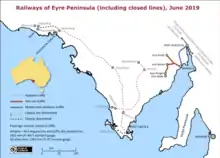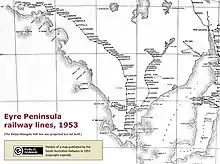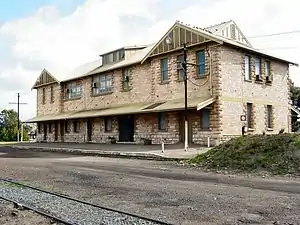Eyre Peninsula Railway
The Eyre Peninsula Railway is a 1,067 mm (3 ft 6 in) gauge railway on the Eyre Peninsula of South Australia. Radiating out from the ports at Port Lincoln and Thevenard, it is isolated from the rest of the South Australian railway network. Peaking at 777 kilometres in 1950, today only one 60 kilometre section remains open. It is operated by One Rail Australia.
| Eyre Peninsula Railway | ||||||||||||||||||||||||||||||||||||||||||||||||||||||||||||||||||||||||||||||||||||||||||||||||||||||||||||||||||||||||||||||||||||||||||||||||||||||||||||||||||||||||||||||||||||||||||||||||||||||||||||||||||||||||||||||||||||||||||||||||||||||||||||||||||||||||||||||||||||||||||||||||
|---|---|---|---|---|---|---|---|---|---|---|---|---|---|---|---|---|---|---|---|---|---|---|---|---|---|---|---|---|---|---|---|---|---|---|---|---|---|---|---|---|---|---|---|---|---|---|---|---|---|---|---|---|---|---|---|---|---|---|---|---|---|---|---|---|---|---|---|---|---|---|---|---|---|---|---|---|---|---|---|---|---|---|---|---|---|---|---|---|---|---|---|---|---|---|---|---|---|---|---|---|---|---|---|---|---|---|---|---|---|---|---|---|---|---|---|---|---|---|---|---|---|---|---|---|---|---|---|---|---|---|---|---|---|---|---|---|---|---|---|---|---|---|---|---|---|---|---|---|---|---|---|---|---|---|---|---|---|---|---|---|---|---|---|---|---|---|---|---|---|---|---|---|---|---|---|---|---|---|---|---|---|---|---|---|---|---|---|---|---|---|---|---|---|---|---|---|---|---|---|---|---|---|---|---|---|---|---|---|---|---|---|---|---|---|---|---|---|---|---|---|---|---|---|---|---|---|---|---|---|---|---|---|---|---|---|---|---|---|---|---|---|---|---|---|---|---|---|---|---|---|---|---|---|---|---|---|---|---|---|---|---|---|---|---|---|---|---|---|---|---|---|---|---|---|---|---|---|---|---|---|---|---|---|---|---|---|---|---|
.jpg.webp) Genesee & Wyoming Australia empty gypsum train at Thevenard in April 2017 | ||||||||||||||||||||||||||||||||||||||||||||||||||||||||||||||||||||||||||||||||||||||||||||||||||||||||||||||||||||||||||||||||||||||||||||||||||||||||||||||||||||||||||||||||||||||||||||||||||||||||||||||||||||||||||||||||||||||||||||||||||||||||||||||||||||||||||||||||||||||||||||||||
| Overview | ||||||||||||||||||||||||||||||||||||||||||||||||||||||||||||||||||||||||||||||||||||||||||||||||||||||||||||||||||||||||||||||||||||||||||||||||||||||||||||||||||||||||||||||||||||||||||||||||||||||||||||||||||||||||||||||||||||||||||||||||||||||||||||||||||||||||||||||||||||||||||||||||
| Owner | Government of South Australia | |||||||||||||||||||||||||||||||||||||||||||||||||||||||||||||||||||||||||||||||||||||||||||||||||||||||||||||||||||||||||||||||||||||||||||||||||||||||||||||||||||||||||||||||||||||||||||||||||||||||||||||||||||||||||||||||||||||||||||||||||||||||||||||||||||||||||||||||||||||||||||||||
| Termini | Port Lincoln Buckleboo Penong | |||||||||||||||||||||||||||||||||||||||||||||||||||||||||||||||||||||||||||||||||||||||||||||||||||||||||||||||||||||||||||||||||||||||||||||||||||||||||||||||||||||||||||||||||||||||||||||||||||||||||||||||||||||||||||||||||||||||||||||||||||||||||||||||||||||||||||||||||||||||||||||||
| Service | ||||||||||||||||||||||||||||||||||||||||||||||||||||||||||||||||||||||||||||||||||||||||||||||||||||||||||||||||||||||||||||||||||||||||||||||||||||||||||||||||||||||||||||||||||||||||||||||||||||||||||||||||||||||||||||||||||||||||||||||||||||||||||||||||||||||||||||||||||||||||||||||||
| Operator(s) | One Rail Australia | |||||||||||||||||||||||||||||||||||||||||||||||||||||||||||||||||||||||||||||||||||||||||||||||||||||||||||||||||||||||||||||||||||||||||||||||||||||||||||||||||||||||||||||||||||||||||||||||||||||||||||||||||||||||||||||||||||||||||||||||||||||||||||||||||||||||||||||||||||||||||||||||
| Depot(s) | 1 | |||||||||||||||||||||||||||||||||||||||||||||||||||||||||||||||||||||||||||||||||||||||||||||||||||||||||||||||||||||||||||||||||||||||||||||||||||||||||||||||||||||||||||||||||||||||||||||||||||||||||||||||||||||||||||||||||||||||||||||||||||||||||||||||||||||||||||||||||||||||||||||||
| History | ||||||||||||||||||||||||||||||||||||||||||||||||||||||||||||||||||||||||||||||||||||||||||||||||||||||||||||||||||||||||||||||||||||||||||||||||||||||||||||||||||||||||||||||||||||||||||||||||||||||||||||||||||||||||||||||||||||||||||||||||||||||||||||||||||||||||||||||||||||||||||||||||
| First section opened | 18 November 1907 | |||||||||||||||||||||||||||||||||||||||||||||||||||||||||||||||||||||||||||||||||||||||||||||||||||||||||||||||||||||||||||||||||||||||||||||||||||||||||||||||||||||||||||||||||||||||||||||||||||||||||||||||||||||||||||||||||||||||||||||||||||||||||||||||||||||||||||||||||||||||||||||||
| Maximum length reached | 11 April 1950 | |||||||||||||||||||||||||||||||||||||||||||||||||||||||||||||||||||||||||||||||||||||||||||||||||||||||||||||||||||||||||||||||||||||||||||||||||||||||||||||||||||||||||||||||||||||||||||||||||||||||||||||||||||||||||||||||||||||||||||||||||||||||||||||||||||||||||||||||||||||||||||||||
| Grain services ceased | 31 May 2019 | |||||||||||||||||||||||||||||||||||||||||||||||||||||||||||||||||||||||||||||||||||||||||||||||||||||||||||||||||||||||||||||||||||||||||||||||||||||||||||||||||||||||||||||||||||||||||||||||||||||||||||||||||||||||||||||||||||||||||||||||||||||||||||||||||||||||||||||||||||||||||||||||
| Technical | ||||||||||||||||||||||||||||||||||||||||||||||||||||||||||||||||||||||||||||||||||||||||||||||||||||||||||||||||||||||||||||||||||||||||||||||||||||||||||||||||||||||||||||||||||||||||||||||||||||||||||||||||||||||||||||||||||||||||||||||||||||||||||||||||||||||||||||||||||||||||||||||||
| Line length | 777 km (483 mi) | |||||||||||||||||||||||||||||||||||||||||||||||||||||||||||||||||||||||||||||||||||||||||||||||||||||||||||||||||||||||||||||||||||||||||||||||||||||||||||||||||||||||||||||||||||||||||||||||||||||||||||||||||||||||||||||||||||||||||||||||||||||||||||||||||||||||||||||||||||||||||||||||
| Track gauge | 1,067 mm (3 ft 6 in) | |||||||||||||||||||||||||||||||||||||||||||||||||||||||||||||||||||||||||||||||||||||||||||||||||||||||||||||||||||||||||||||||||||||||||||||||||||||||||||||||||||||||||||||||||||||||||||||||||||||||||||||||||||||||||||||||||||||||||||||||||||||||||||||||||||||||||||||||||||||||||||||||
| ||||||||||||||||||||||||||||||||||||||||||||||||||||||||||||||||||||||||||||||||||||||||||||||||||||||||||||||||||||||||||||||||||||||||||||||||||||||||||||||||||||||||||||||||||||||||||||||||||||||||||||||||||||||||||||||||||||||||||||||||||||||||||||||||||||||||||||||||||||||||||||||||
History


The Eyre Peninsula Railway was built and operated by the South Australian Railways (SAR). As with many other early narrow-gauge railways in South Australia, the Eyre Peninsula lines started out as isolated lines connecting small ports to the inland, opening up the country for settlement and economic life including export of grain and other produce in an environment with few roads and only horse-drawn road vehicles.[2] The railway has always been isolated from the main network. A proposal to link it with the rest of the network at Port Augusta was rejected in the 1920s[3][4] and again in the 1950s.[5][6]
The first 67 kilometres from Port Lincoln to Cummins opened on 18 November 1907, followed by extensions to Yeelanna on 1 April 1909, Minnipa on 5 May 1913, Nunjikompita on 14 August 1914 and Thevenard on 8 February 1915, a total of 434 kilometres.[7][8][9] A second line opened from Cummins to Moody on 1 August 1912, being extended to Ungarra on 31 March 1913, Kimba on 11 July 1913 and Buckleboo on 5 August 1926, a distance of 213 kilometres.[10]
Branch lines off the original line opened from Yeelanna to Mount Hope on 9 October 1914, a distance of 38 kilometres and from Wandana to Penong on 7 February 1924, a distance of 83 kilometres.[11] A further nine kilometre branch from Kevin to Kowulka opened on 11 April 1950. This was the peak of the network's size at 777 kilometres.[10]
The Mount Hope line was truncated by 15 kilometres on 12 July 1965, with Kapinnie becoming its terminus.[10][12] The remaining section closed in October 2002.[9]
The original route for gypsum traffic had followed a circuitous, 103 kilometres (64 miles) route, via Kowulka and Wandana, from the mine at Kevin to the port at Thevenard. The ruling grade was 1 in 80. In 1966, a 58 km (36 mi) line with a ruling grade of 1 in 120 was opened from Kevin to Penong Junction.[13]The line from Wandana to Kowulka was closed.[10][14][15] In 1984 the Thevenard unloading facility was upgraded with a balloon loop.[16]
The Eyre Peninsula Railway was included in the March 1978 takeover of the SAR by Australian National and the November 1997 sale of Australian National's South Australian freight business to Genesee & Wyoming which included a 50-year lease on the rail network from the state government until 2047.[17][18][19]
The last grain train from Kevin to Penong operated on 3 March 1997 with the line reverting to state government ownership on 30 June 2001.[9] Due to a poor harvest resulting from drought, the last grain train north of Cummins to Kimba ran on 20 December 2018.[20]
Grain trains ceased operating in May 2019, with Viterra moving its business to road haulage with much of the network closed.[21][22] The network technically remains open as no lines have formally been 'closed'. However, from an operational standpoint, the lines are closed. Since April 2005, grain trains had only operated from Port Lincoln to Wudinna and Kimba.[23][24][25] The workshops in Port Lincoln initially remained open for ongoing railway wagon maintenance brought in by road from Whyalla and Thevenard, but the workshops have now closed. The maintenance is now done at the Port Augusta workshops.
The Wudinna to Penong Junction section remained open to facilitate rolling stock movements to and from the Port Lincoln workshops.[26][27] Gypsum trains continue to operate from the Lake MacDonnell mine at Kevin to Thevenard for Gypsum Resources Australia, a joint venture between Boral and CSR.[28][29] A final light engine movement from Port Lincoln to Thevenard ran on 26 June 2019.[20]
Lines
| Lines | |||
|---|---|---|---|
| From | To | Distance (Kilometres) | Notes |
| Port Lincoln | Thevenard | 434 | Opened to Cummins 18 November 1907, Yeelanna 1 April 1909, Minnipa 5 May 1913, Nunjikompita 14 August 1914, Thevenard 8 February 1915[10] |
| Cummins | Buckleboo | 213 | Opened to Moody 1 August 1912, to Ungarra 31 March 1913, Kimba 11 July 1913, Buckleboo 5 August 1926, last train beyond Kimba ran in March 2005[10][30] |
| Yeelanna | Mount Hope | 38 | Opened 9 October 1914, cut back to Kapinnie 12 July 1965, remainder closed October 2002[10][30] Last known through vehicles were operated by ASSCO[31] |
| Wandana | Penong | 83 | Opened 7 February 1924, Wandana to Kowulka closed 13 February 1966, Kowulka to Penong closed 3 March 1997[10] Last Lessor ASSCO January 2003 [32] |
| Penong Junction | Kowulka | 69 | Kevin to Kowulka opened 11 April 1950, Penong Junction to Kevin opened 13 February 1966[10] |
Services
Freight
Today the Eyre Peninsula Railway only carries gypsum with three returns trains daily. In 2017, 1.55 million tonnes of gypsum was transported.[33] Previously grain, livestock, oil, salt, superphosphate and water was carried.[9][30]
Passenger
Initially passengers were conveyed on mixed trains. A weekly passenger service from Port Lincoln to Thevenard was introduced in 1923 that included a sleeping car. It operated as a boat train being positioned at the foot of the jetty at Port Lincoln to connect with ships from Adelaide. In 1931 Fageol railbuses converted from motor buses were introduced, these were supplemented by Brill 75s in 1936. The last service was withdrawn on 30 August 1968.[9][34][35]
Rolling stock
The Eyre Peninsula Railway was operated by T, V, W and Y class steam locomotives. All had previously been used on other parts of the SAR network. These were replaced by 830 class diesel locomotives in the 1960s. Nine were delivered new to the Eyre Peninsula Railway, while others were transferred from the Port Pirie to Broken Hill line after it was converted to standard gauge replacing the last steam locomotives in April 1970.[9]
Some 830s were transferred to AN Tasrail in the early 1980s and replaced by ex Commonwealth Railways NT and NJ class locomotives made redundant by the closure of the Central Australia Railway.[9][36] As of January 2019, the locomotive fleet comprised seven 830s (including three rebuilt as 900s), three NJs and two ex Australian Railroad Group As locomotives.[24] As of April 2020, The Thevenard locomotive fleet is worked by six 830 class variants and the 3 remaining 1600/NJ class units.
Rolling stock was maintained under contract by Clyde Engineering and Downer Rail from 1997 until brought back in house in 2014. The infrastructure is maintained by Broadspectrum.[30]
Depots
When the line opened, a depot was established at Cummins with locomotives sent to Islington Railway Workshops in Adelaide for major work. From 1931 the railway was able to handle all level of repairs with the establishment of a workshop at Port Lincoln with a roundhouse opened in 1934. The workshop was rebuilt in 1966 to service diesel locomotives.[30]
As well as maintaining the Eyre Peninsula fleet, in later years Downer Rail used the Port Lincoln depot for external work including rebuilding five Queensland Rail 2100s for further use with Australian Railroad Group, and 830s, CKs and DAs for the Whyalla Steelworks network.[30][37] In 2019, the locomotive depot was nominated for inclusion on the South Australian Heritage Register.[38] As of December 2019, the locomotive workshops and roundhouse have been provisionally listed on the register.[38]
A locomotive shed was also established at Thevenard and replaced by a small locomotive servicing facility in 1992.[9] With the closure of the grain network, the Thevenard facility was expected to be upgraded when the Port Lincoln depot closed.[39] As of December 2019, the Port Lincoln Workshops remained open for re-skinning wagon interiors brought in by road from the nearby BHP Whyalla Tramway.[40]
References
- Eyre Peninsula Lines SA Track & Signal
- "The Eyre Peninsula". Australian Railway Historical Society Bulletin. No. 703. May 1996. p. 148.
- "Kimba Railway". The Transcontinental. 9 July 1920. p. 1. Archived from the original on 14 May 2019 – via National Library of Australia.
- "Kimba-Port Augusta Railway". The Register. 16 August 1922. p. 3. Archived from the original on 13 May 2019 – via National Library of Australia.
- "No Railway Link with West Coast". Quorn Mercury. 24 June 1954. p. 1 – via National Library of Australia.
- "Extension of Railway Opposed". Whyalla Times. 2 July 1954. p. 1 – via National Library of Australia.
- "The Port Lincoln Railway Act 1905 No. 882" (PDF). Government of South Australia. 8 November 1905. Archived from the original (PDF) on 9 April 2019.
- "The Port Lincoln Railway Extension Act 1909 No. 985" (PDF). Government of South Australia. 11 December 1909. Archived from the original (PDF) on 9 April 2019.
- Knife, Peter (2006). Peninsula Pioneer. Wahroonga: Peter Knife. ISBN 0975783505.
- Newland, Andrew; Quinlan, Howard (2000). Australian Railway Routes 1854 - 2000. Redfern: Australian Railway Historical Society. p. 59. ISBN 0-909650-49-7.
- "The Mount Hope Railway Act 1912 No. 1094" (PDF). Government of South Australia. 12 December 1912. Archived from the original (PDF) on 9 April 2019.
- "Kapinnie and Mount Hope Railway Discontinuance Act 1966 No. 11" (PDF). Government of South Australia. 24 February 1966. Archived from the original (PDF) on 9 April 2019.
- "Ceduna-Kevin Railway Under Construction for SAR". Network. August 1965. p. 2.
- "Opening of New Ceduna - Kevin Line". The Recorder. March 1966. pp. 1–2.
- "Thevenard to Kevin Railway Act, 1963, No. 9" (PDF). Government of Australia. 10 October 1963. Archived from the original (PDF) on 9 April 2019.
- "Gypsum facilities upgraded in modernisation program". Freight & Container Transportation. December 1984. p. 30.
- "Three Systems Amalgamate on 1 March". Network. January 1978. p. 7.
- "Three groups take on AN remains". Railway Gazette International. October 1997. p. 703.
- Genesee & Wyoming. "Annual Report for year ended 31 December 2014" (PDF). Archived from the original (PDF) on 20 October 2017 – via AnnualReports.com.
- "Farewell Eyre Peninsula Grainies". Catch Point. No. 252. July 2019. p. 10.
- "Eyre Peninsula rail to close as agreement ends". Port Lincoln Times. 26 February 2019. Archived from the original on 22 March 2019.
- "Viterra to transition to road transport for movement of all grain on Eyre Peninsula". ABC News. 26 February 2019.
- Knife, Peter; Knife, Margaret (2007). Peninsula Memories: Stories of the railwaymen and women of Eyre Peninsula. Wahroonga: Peter Knife. ISBN 9780975783511.
- "End of The Line for the Eyre Peninsula Railway". Motive Power. No. 122. March 2019. pp. 30–39.
- "Storage & Handling Network" (PDF). Viterra. July 2017. Archived from the original (PDF) on 18 April 2019.
- "Eyre Peninsula Lines" (PDF). SA Track & Signal. Archived from the original (PDF) on 6 April 2019.
- "Eyre Peninsula grain movements to cease at end of May". Railway Digest. April 2018. p. 18.
- "No changes to gypsum rail service". West Coast Sentinel. 8 March 2019. Archived from the original on 9 April 2019.
- "Eyre Peninsula Freight Study Released". Regional Development Australia Whyalla & Eyre Peninsula. 8 April 2019. Archived from the original on 9 April 2019.
- Knife, Peter (2013). Peninsula Pioneer Revisited. Wahroonga: Peter Knife. ISBN 9780975783535.
- "ASSCO; Eyre Peninsula Run". Catchpoint. National Railway Museum, Port Adelaide. May 2002.
- "Section Cars return to Penong Railway". West Coast Sentinel. 30 January 2003.
- SMEC Holdings (September 2018). "Eyre Peninsula Freight Study" (PDF). Archived from the original (PDF) on 16 May 2019.
- "Rail Services to be Cut". Victor Harbor Times. 10 May 1968. p. 6 – via National Library of Australia.
- "Port Lincoln Division - Withdrawal of Passenger Service". The Recorder. August 1968. pp. 1–4.
- "The Eyre Peninsula's Isolated Railway". Railway Digest. July 2001. pp. 12–16.
- "The Queensland Invasion West". Motive Power. No. 106. July 2016. p. 49.
- "Nominations for the SA Heritage Register". Nominations Provisionally Entered in the SA Heritage Register. Archived from the original on 30 May 2019.
- "EP Grain Rail Set to Close - 31 May 2019". Catch Point. No. 250. March 2019. p. 8.
- "Port Lincoln Station Update & Final Wagon Movements". Catch Point. No. 255. January 2020. pp. 32–25.
Further reading
External links
![]() Media related to Eyre Peninsula Railway at Wikimedia Commons
Media related to Eyre Peninsula Railway at Wikimedia Commons
- Peninsula Pioneer website – dedicated to the history of the railways of Eyre Peninsula

_locomotive_1606_at_Thevenard_Maintenance_Centre_in_2017_(02).jpg.webp)